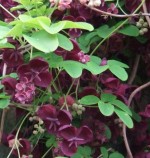 Also called chocolate vine, this twining, deciduous, woody vine is native to Japan, China, and Korea but was introduced into the US in 1845 as an ornamental and is now invasive from Massachusetts to Michigan, south to Georgia and Louisiana. It invades forests and forms dense mats that displace native vegetation or or climbs and smothers small trees and shrubs. The vine grows up to 40’ long and has compound leave up to three inches longs with five oval leaflets. Pendent axillary racemes of wine-red, chocolate scented flowers appear in the spring and give way to sausage-shaped pods up to four inches long. Plants like full sun to part shade and medium moist, well-drained soil but tolerant dense shade and some drought. USDA Hardiness Zones 4-8
Also called chocolate vine, this twining, deciduous, woody vine is native to Japan, China, and Korea but was introduced into the US in 1845 as an ornamental and is now invasive from Massachusetts to Michigan, south to Georgia and Louisiana. It invades forests and forms dense mats that displace native vegetation or or climbs and smothers small trees and shrubs. The vine grows up to 40’ long and has compound leave up to three inches longs with five oval leaflets. Pendent axillary racemes of wine-red, chocolate scented flowers appear in the spring and give way to sausage-shaped pods up to four inches long. Plants like full sun to part shade and medium moist, well-drained soil but tolerant dense shade and some drought. USDA Hardiness Zones 4-8
The following natives are recommended as alternatives:
Trumpet Vine (Campsis radicans)
Climbing by holdfasts, this vigorous deciduous vine grows up to 40’ long and has pinnately divided leaves with 9-11 toothed leftlets that turn yellow in the fall. The trumpet shaped flowers are orange and appear in the summer. The plant is native to woodland borders, clearings, meadows, and roadside fences and trees from Pennsylvania to Missouri, south to Florida and Texas. USDA Hardiness Zone 4-9
Scarlet Clematis (Clematis texensis)
Also called scarlet leather flower, this climbing semi-woody vine is endemic to Texas where it grows on rocky limestone cliffs and streamsides. It grows up to nine feet long and has pinnate to bipinnate leaves with rounded to ovate leaflets up to 1.5” long. The small tulip-shaped flowers have thick, leather-like red sepals that resemble petals and are followed by feather seedheads. USDA Hardiness Zones 4-8
Leatherflower (Clematis viorna)
Leatherflower is a deciduous or evergreen vine native to southeastern Pennsylvania and Delaware south to Georgia, and west to Missouri and Arkansas where it grows in mesic forests and woodlands. It grows 6-10 ‘ long and has pinnately divided leaves with 4-8 oval to lanceolate leaflets that may be lobed or further divided, and a terminal leaflet that looks like a tendril. One to seven flowers appear in the leaf axils from late spring through summer and are 1” long, bell-shaped to urn-shaped, and have thick fleshy petal-like violet to dull purple sepals. They are followed by fluffy seedheads. USDA Hardiness Zones 4-8
Wild Hydrangea Vine (Decumaria barbara)
Also called climbing hydrangea, this woody vine grows up to 60’ long and has root-like holdfasts for climbing. It has dark reddish to gray-brown bark with numerous arial rootlets and dark green leaves with pale undersides. The vine must climb to produce flowers. The small white flowers appear in terminal clusters 2-4” across in late spring. Plants are native to bottomland forests of southeastern US. USDA Hardiness Zones 6-8
Trumpet Honeysuckle (Lonicera sempervirens)
Also called scarlet honeysuckle, this evergreen or deciduous twining vine is native to Connecticut to Nebraska south to Florida and Texas, where it grows in low open woods, woodland margins, and roadsides . It grows up to 20’ and has exfoliating stems and pairs of oval sea-green leaves. The trumpet-shaped flowers are scarlet to red-orange and appear in terminal whorled clusters in late spring. The inedible berries that follow are ornamentally attractive and provide food for birds. USDA Hardiness Zones 4-8
Virginia Creeper (Parthenocissus quinquefolia)
This woody deciduous vine grows thirty to fifty feet long and has palmate leaves with five leaflets that turn bright red to burgundy in fall while indigo berries appear on cerise stalks. It is native to woodland borders, clearings, meadows, and roadside from Quebec, Manitoba and Utah, south to Florida and Texas. USDA Hardiness Zones 3-9